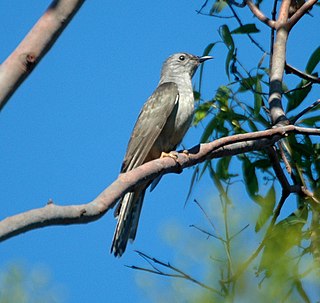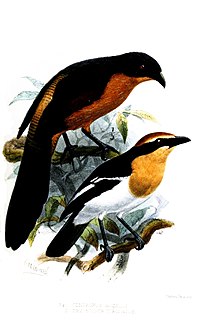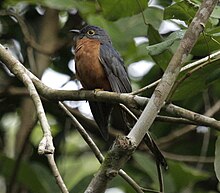
The grey-bellied cuckoo or the Indian plaintive cuckoo is a cuckoo with widespread occurrence throughout Asia.

The brush cuckoo is a member of the cuckoo family.

The Javan hawk-eagle is a medium-sized, dark brown raptor in the family Accipitridae. It is the national bird of Indonesia, where it is commonly referred to as Garuda, from the bird-like creatures in Hindu and Buddhist mythology. The scientific name commemorates the Bartels family, who discovered it.

The black-collared hawk is a species of bird of prey in the family Accipitridae. It is monotypic within the genus Busarellus. It has a widespread range of presence, from western Mexico to Uruguay. Its natural habitats are subtropical or tropical moist lowland forests, subtropical or tropical swamps, and swamps.

Cacomantis is a genus of cuckoo in the family Cuculidae. The genus name is derived from the Greek kakos meaning evil or ill-boding and mantis for prophet and is derived from their association with "rains" being supposed to be predicted as also ill fortune and bad weather. Most of them have a round nostril and are mainly in brown and gray colours. The tails are graduated and barred. The bars are transverse in sonneratii and oblique in all others.

The fan-tailed cuckoo is a species of cuckoo in the family Cuculidae. It is found in Australia, Fiji, New Caledonia, New Zealand, New Guinea, Solomon Islands, and Vanuatu.

The Gabon coucal is a species of cuckoo in the family Cuculidae. It is mainly found in Gabon but also occurs in neighboring areas of Cameroon, Angola, the Central African Republic, the western Congo Basin and Equatorial Guinea.

The blue-headed coucal is a species of cuckoo in the family Cuculidae. It is native to tropical central Africa where its typical habitat is swamps, river banks, forest edges and generally wet locations. It is a common bird with a wide range, and the International Union for Conservation of Nature has rated its conservation status as being of "least concern".

The pheasant coucal is a species of cuckoo in the family Cuculidae. It is found in Australia, Timor and New Guinea. Its natural habitats are subtropical or tropical moist lowland forests and subtropical or tropical mangrove forests. It has adapted well to canefields in northern Australia. The pheasant coucal is unusual among Australian cuckoos in that it incubates and raises its own young instead of laying its eggs in the nest of another species.

The violet cuckoo is a species of cuckoo in the family Cuculidae.

The pheasant cuckoo is a species of neotropical cuckoo in the subfamily Neomorphinae of the family Cuculidae. It is native to Central and South America where it occurs in lowland tropical forest.

The large frogmouth is a species of bird in the family Podargidae. It is found in Brunei, Indonesia, Malaysia, and Thailand, in subtropical or tropical moist lowland forest. Logging of its habitat poses a risk to its survival, and the International Union for Conservation of Nature has listed it as being "near-threatened".

The scaly-breasted kingfisher or regent kingfisher is a species of bird in the family Alcedinidae endemic to central and southwestern Sulawesi in Indonesia. Its natural habitat is subtropical or tropical, moist, montane forests.

The mountain kingfisher is a species of bird in the subfamily Halcyoninae in the family Alcedinidae. Adult males are 21–24 cm (8.3–9.4 in) long, and have a rufous head and underparts, greenish-blue upperparts, a dark blue tail, and black flight feathers. They also have dark neck patches and loral patches. Females have dark crowns and the neck patches join at the nape. It is similar to the yellow-billed kingfisher, but can be distinguished by its larger size and a proportionally larger bill, along with a dark ridge along its culmen.

The Andaman crake is a bird species in the family Rallidae. It is endemic to the Andaman Islands of the eastern Indian Ocean.

The white-bellied cuckooshrike is a species of bird in the family Campephagidae. It is found in Australia, the Moluccas, New Guinea and the Solomon Islands.

The rose robin is a small passerine bird native to Australia. Like many brightly coloured robins of the Petroicidae, it is sexually dimorphic. The male has a distinctive pink breast. Its upperparts are dark grey with white frons, and its tail black with white tips. The underparts and shoulder are white. The female is an undistinguished grey-brown. The robin has a small black bill and eyes.

The large-billed scrubwren is a passerine bird in the family Acanthizidae, endemic to eastern Australia. It is found in denser undergrowth in temperate forest, subtropical or tropical moist lowland forest, and subtropical or tropical moist montane forest.

The stripe-breasted woodpecker is a species of bird in the woodpecker family, Picidae. It is found in Southeast Asia within subtropical or tropical moist lowland forest and subtropical or tropical moist montane forest.

The white-fronted woodpecker is a species of bird in the family Picidae. It is found mainly in Bolivia, Paraguay and Argentina. Its natural habitats are subtropical or tropical dry forests, subtropical or tropical dry shrubland, and subtropical or tropical high-altitude shrubland.




















